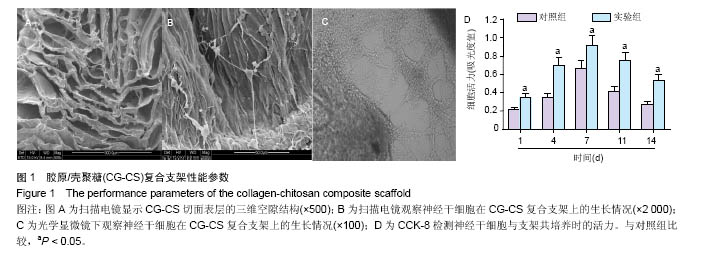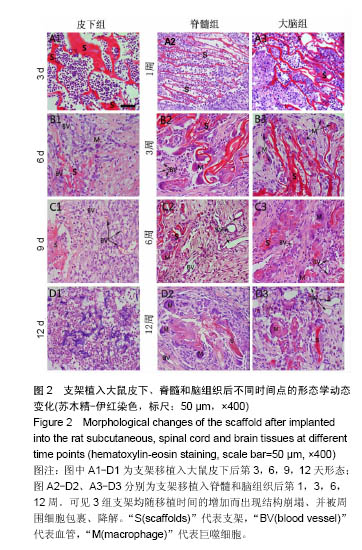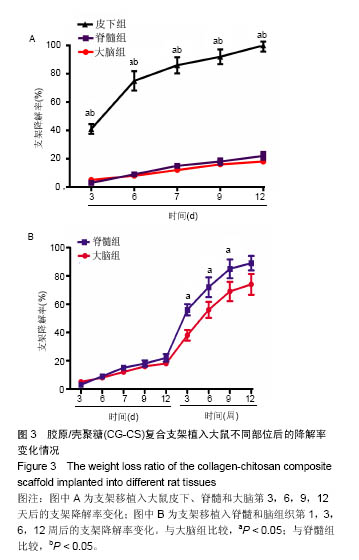| [1]Bhattacharya I, Ghayor C, Weber FE. The use of adipose tissue-derived progenitors in bone tissue engineering-a review. Transfus Med Hemother. 2016;43(5):336-343.[2]Hussein KH, Park KM, Kang KS, et al. Biocompatibility evaluation of tissue-engineered decellularized scaffolds for biomedical application. Mater Sci Eng C Mater Biol Appl. 2016;67:766-778.[3]Yamada S, Yamamoto K, Ikeda T, et al. Potency of fish collagen as a scaffold for regenerative medicine. Biomed Res Int. 2014;2014:302932.[4]Yarlagadda PK, Chandrasekharan M, Shyan JY. Recent advances and current developments in tissue scaffolding. Biomed Mater Eng. 2005;15:159-177.[5]Dzul SP, Rocha AG, Rawat S, et al. In vitro characterization of a novel Isu homologue from Drosophila melanogaster for de novo FeS-cluster formation. Metallomics. 2016.[6]Yue S, Lee PD, Poologasundarampillai G, et al. Evaluation of 3-D bioactive glass scaffolds dissolution in a perfusion flow system with X-ray microtomography. Acta Biomater. 2011;7(6):2637-2643.[7]Cheng N, Wang Y, Zhang Y, et al. The osteogenic potential of mesoporous bioglasses/silk and non-mesoporous bioglasses/silk scaffolds in ovariectomized rats: in vitro and in vivo evaluation. PLoS One. 2013;8(11):e81014.[8]Rossi E, Gerges I, Tocchio A, et al. Biologically and mechanically driven design of an RGD-mimetic macroporous foam for adipose tissue engineering applications. Biomaterials. 2016;104:65-77.[9]Yi J, Xiong F, Li B, et al. Degradation characteristics, cell viability and host tissue responses of PDLLA-based scaffold with PRGD and beta-TCP nanoparticles incorporation. Regen Biomater. 2016;3(3):159-166.[10]Muthukumar T, Aravinthan A, Sharmila J, et al. Collagen/chitosan porous bone tissue engineering composite scaffold incorporated with Ginseng compound K. Carbohydr Polym. 2016;152:566-574.[11]Giretova M, Medvecky L, Stulajterova R, et al. Effect of enzymatic degradation of chitosan in polyhydroxybutyrate/ chitosan/calcium phosphate composites on in vitro osteoblast response. J Mater Sci Mater Med. 2016;27(12): 181.[12]Nguyen VT, Ko SC, Oh GW, et al. Anti-inflammatory effects of sodium alginate/gelatine porous scaffolds merged with fucoidan in murine microglial BV2 cells. International journal of biological macromolecules. 2016;93:1620-1632.[13]Neshati Z, Bahrami AR, Eshtiagh-Hosseini H, et al. Evaluating the biodegradability of Gelatin/Siloxane/ Hydroxyapatite (GS-Hyd) complex in vivo and its ability for adhesion and proliferation of rat bone marrow mesenchymal stem cells. Cytotechnology. 2012;64(5): 485-495.[14]杜倩.壳聚糖-胶原角膜修复材料的制备及生物相容性[J].中国组织工程研究,2015,19(52):8433-8437.[15]Zeng S, Liu L, Shi Y, et al. Characterization of Silk Fibroin/Chitosan 3D Porous Scaffold and In Vitro Cytology. PLoS One. 2015;10(6):e0128658.[16]邢冉,陈旭义,朱祥,等.神经干细胞在新型复合支架中的生长和分化[J].中国组织工程研究,2016,20(19):2857-2863.[17]Jinno C, Morimoto N, Ito R, et al. A Comparison of Conventional Collagen Sponge and Collagen-Gelatin Sponge in Wound Healing. Biomed Res Int. 2016;2016: 4567146.[18]Yang Y, Melzer C, Bucan V, et al. Conditioned umbilical cord tissue provides a natural three-dimensional storage compartment as in vitro stem cell niche for human mesenchymal stroma/stem cells. Stem Cell Res Ther. 2016;7:28.[19]陆瑞欣.神经干细胞在胶原凝胶及胶原-壳聚糖支架内的培养[D].大连:大连理工大学,2009.[20]Loh QL, Choong C. Three-dimensional scaffolds for tissue engineering applications: role of porosity and pore size. Tissue engineering Part B Reviews. 2013;19:485-502.[21]Cheng NC, Wang S, Young TH. The influence of spheroid formation of human adipose-derived stem cells on chitosan films on stemness and differentiation capabilities. Biomaterials. 2012;33:1748-1758.[22]Martinez A, Blanco MD, Davidenko N, et al. Tailoring chitosan/collagen scaffolds for tissue engineering: Effect of composition and different crosslinking agents on scaffold properties. Carbohydrate Polymers. 2015;132:606-619.[23]Gorham SD, Light ND, Diamond AM, et al. Effect of chemical modifications on the susceptibility of collagen to proteolysis. II. Dehydrothermal crosslinking. Int J Biol Macromol. 1992;14(3):129-138.[24]Martins AM, Kretlow JD, Costa-Pinto AR, et al. Gradual pore formation in natural origin scaffolds throughout subcutaneous implantation. J Biomed Mater Res A. 2012; 100(3):599-612.[25]Brown BN, Valentin JE, Stewart-Akers AM, et al. Macrophage phenotype and remodeling outcomes in response to biologic scaffolds with and without a cellular component. Biomaterials. 2009;30(8):1482-1491.[26]Durkut S, Elcin YM, Elcin AE. Biodegradation of chitosan-tripolyphosphate beads: in vitro and in vivo studies. Artif Cells Blood Substit Immobil Biotechnol. 2006;34(2): 263-276.[27]Xia Z, Triffitt JT. A review on macrophage responses to biomaterials. Biomed Mater. 2006;1(1):R1-R9.[28]Stein M, Keshav S, Harris N, et al. Interleukin 4 potently enhances murine macrophage mannose receptor activity: a marker of alternative immunologic macrophage activation. J Exp Med. 1992;176(1):287-292.[29]Wesley RB 2nd, Meng X, Godin D, et al. Extracellular matrix modulates macrophage functions characteristic to atheroma: collagen type I enhances acquisition of resident macrophage traits by human peripheral blood monocytes in vitro. Arterioscler Thromb Vasc Biol. 1998;18(3):432-440.[30]邓倩莹,李立华,李毅群,等.溶菌酶、过氧化氢对壳聚糖降解性能的影响[J].化学世界,2005,45(6):338-340.[31]Lim SM, Song DK, Oh SH, et al. In vitro and in vivo degradation behavior of acetylated chitosan porous beads. J Biomater Sci Polym Ed. 2008;19(4):453-466.[32]Ishida T, Takeuchi K, Hayashi S, et al. Anatomical structure of the subcutaneous tissue on the anterior surface of human thigh. Okajimas Folia Anat Jpn. 2015;92(1):1-6.[33]Lis A, Szarek D, Laska J. Biomaterials engineering strategies for spinal cord regeneration: state of the art. Polim Med. 2013;43(2):59-80.[34]Breuer Z, Mayevsky A. Brain vasculature and mitochondrial responses to ischemia in gerbils. II. Strain differences and statistical evaluation. Brain Res. 1992;598(1-2):251-256.[35]Ma S, Adayi A, Liu Z, et al. Asymmetric collagen/chitosan membrane containing minocycline-loaded chitosan nanoparticles for guided bone regeneration. Sci Rep. 2016;6:31822.[36]Spiller KL, Anfang RR, Spiller KJ, et al. The role of macrophage phenotype in vascularization of tissue engineering scaffolds. Biomaterials. 2014;35(15):4477- 4488.[37]Huang KF, Hsu WC, Hsiao JK, et al. Collagen- glycosaminoglycan matrix implantation promotes angiogenesis following surgical brain trauma. Biomed Res Int. 2014;2014:672409. |
.jpg)





.jpg)